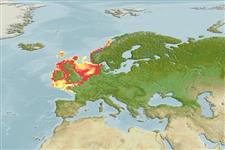Common names from other countries
Environment: milieu / climate zone / depth range / distribution range
Ecologie
marien; brak water demersaal; oceanodroom (Ref. 51243); diepte 0 - 100 m (Ref. 35388), usually 10 - 20 m (Ref. 1371). Temperate; 68°N - 44°N, 11°W - 13°E
Northeast Atlantic: Trondheim on the Norwegian coast to the Bay of Biscay; also around the British Isles.
Grootte / Gewicht / Leeftijd
Maturity: Lm ? range ? - ? cm
Max length : 30.0 cm TL mannelijk / geslacht onbekend; (Ref. 1371); common length : 20.0 cm TL mannelijk / geslacht onbekend; (Ref. 4645)
Dorsale stekels (totaal) : 0; Anale stekels: 0. Head depressed. First dorsal fin poorly developed, with only three short rays. Color uniformly dark brown or bluish brown; the lips and the distal areas of all fins paler except for the pectorals.
Lives in coastal waters at shallow depths, generally from 10-20 m, more seldom from 75-100 m, on rocky bottom with seaweeds. Solitary and secretive, undertakes only limited local movements. Spawns from May to September at 50-70 m depth near the shore throughout its entire range. Feeds on sea stars, crustaceans, worms, mollusks and small fish (Ref. 1371).
Oviparous, sexes are separate (Ref. 205).
Cohen, D.M., T. Inada, T. Iwamoto and N. Scialabba, 1990. FAO species catalogue. Vol. 10. Gadiform fishes of the world (Order Gadiformes). An annotated and illustrated catalogue of cods, hakes, grenadiers and other gadiform fishes known to date. FAO Fish. Synop. 125(10). Rome: FAO. 442 p. (Ref. 1371)
Status op de Rode Lijst van het IUCN (Ref. 130435)
CITES (Ref. 128078)
Not Evaluated
Gevaar voor de mens
Harmless
Gebruik door de mens
Visserij: van geen belang; Aquarium: Publieke aquaria
Tools
Speciale rapporten
Download XML
Internetbronnen
Estimates based on models
Preferred temperature (Ref.
115969): 8.5 - 12.5, mean 10.4 (based on 120 cells).
Fylogenetische diversiteitsindex (Ref.
82804): PD
50 = 1.0000 [Uniqueness, from 0.5 = low to 2.0 = high].
Bayesian length-weight: a=0.01072 (0.00412 - 0.02789), b=3.06 (2.83 - 3.29), in cm Total Length, based on LWR estimates for this (Sub)family-body shape (Ref.
93245).
Trofisch niveau (Ref.
69278): 3.8 ±0.56 se; based on food items.
Fishing Vulnerability (Ref.
59153): Low vulnerability (20 of 100).
